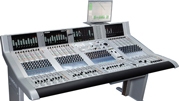Studer offers perspective on console selection for live TV production

With the arrival of digital television and the increasing prevalence of HDTV in the home, the growth of 5.1 surround sound in broadcasting is just beginning. HDTV is not only about better quality of picture, but also about an enhanced listening experience in the home. With this growing trend, choosing an audio console for live TV production is becoming a more important decision.
Control surface design is the largest difference among console manufacturers today. For live TV, ease of use and speed of operation are key elements in ensuring error-free productions. Flexibility and functionality are, of course, also important factors, because new software functionality is constantly required and must be accommodated. For console manufacturers, the challenge is to offer a concept of operation that is intuitive for the operator, but can also withstand the constant evolution of new functionality.
In early digital consoles, the concept of “central assign” was very popular because it allowed a radical reduction in console size and the number of physical controls on the surface. This approach proved to have drawbacks due to its lack of full-console overview and was problematic for operators due to the constant “mind mapping” required to visualize the big picture.
The Studer Vista 8 operates with the principle philosophy of channel strip operation. Most operators find this very intuitive because one’s instinct is always to go where the channel fader is located to access its functions. The company’s Vistonics interface offers an overview of the channel settings that promote intuitive operation. This also frees the operator to concentrate on the creative and operational role of the mixer. The Vistonics design concept includes a “one touch to access” rule, which means that no console function is ever more than one button-push away. This is essential for the high-pressure environment of live TV.
For most broadcasters, a live broadcast digital console must be able to handle basic post-production work. With such a multipurpose studio, the audio console must offer a changeable channel bus/architecture to fit the various applications. Studer designs incorporate DSP algorithms that allow the customer to easily update existing setups with any new functionality that is required.
In the TV environment, system integration of the audio console is becoming increasingly important. The Vista 8 offers a completely modular I/O hardware concept that requires no advanced prewiring. The 96kHz I/O system allows Studer to design and add new cards to the system on a plug-and-play basis as new formats become available, such as the recent HD-SDI embedder/de-embedder. Studer’s Dolby E decoder cards make it possible to have 24 Dolby E decoders in a single 3RU frame with redundant power supplies. In addition, this approach reduces potential points of failure by eliminating the need for an external solution; thus, the Vista 8’s internal router can act as the main audio router of a studio or truck. This is very elegant from a system point of view because it enables console router control by third-party video control systems such as NVISION, Grass Valley Pro-Bel and Leitch.
For more information, visit www.studer.ch.
Get the TV Tech Newsletter
The professional video industry's #1 source for news, trends and product and tech information. Sign up below.
